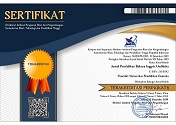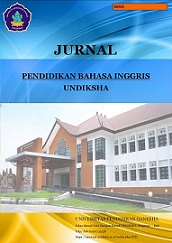STUDENTS AND PARENTS’ PERCEPTIONS TOWARD ENGLISH ONLINE LEARNING DURING CORONA VIRUS PANDEMIC
DOI:
https://doi.org/10.23887/jpbi.v9i1.35049Keywords:
Online Learning, Traditional Method, PerceptionAbstract
E-learning dramatically changes the learning process. As a result, both teachers and students have to work hard to adapt to the process. In response to these changes, this study aims to analyze the perceptions of junior high school, senior high school, and parents regarding online learning. This study involved 44 parents, 24 junior high school students, and 20 high school students. Data were collected using two questionnaires. The data collected were analyzed quantitatively in the form of percentages. The results of data analysis show that junior high school students use computers/devices for online learning activities; however, they consider traditional methods (live class meetings) to be more appropriate than online learning. (2) High school students also use their computers/devices for online learning and have full support from their teachers, but they prefer traditional methods. They consider traditional methods more effective than online learning, and (3) parents prefer traditional methods over online learning. Therefore, teachers are advised to be creative in teaching online; parents are expected to continue to control their students' online learning. More research is needed so that more information about online learning can be obtained.
References
Abbasi, S., Ayoob, T., Malik, A., & Memon, S. I. (2020). Perceptions of Students Regarding E-Learning during Covid-19 at a Private Medical College. Pak J Med Sci, 36. https://doi.org/10.12669%2Fpjms.36.COVID19-S4.2766
Almaiah, M. A., Al-Khasawneh, A., & Althunibat, A. (2020). Exploring the critical challenges and factors influencing the E-learning system usage during COVID-19 pandemic. Education and Information Technologies, 25(6), 5261–5280. https://doi.org/10.1007/s10639-020-10219-y
Amalia, F., & Brata, A. H. (2018). Analisis Tingkat Penerimaan Sistem E-Learning menggunakan Blog Gratis sebagai Alternatif Media Pembelajaran pada Guru. Jurnal Teknologi Informasi Dan Ilmu Komputer, 5(3), 335. https://doi.org/10.25126/jtiik.201853640
Amiti, F. (2020). Synchronous and asynchronous E-learning. European Journal of Open Education and E-Learning Studies, 5(2), 60–70. https://doi.org/10.46827/ejoe.v5i2.3313
Astuti, M., Arifin, Z., Mutohhari, F., & Nurtanto, M. (2021). Competency of Digital Technology: The Maturity Levels of Teachers and Students in Vocational Education in Indonesia. Journal of Education Technology, 5(2), 254–262. https://doi.org/10.23887/jet.v5i3.35108
Bastemur, S., & Bastemur, E. (2015). Technology Based Counseling: Perspectives of Turkish Counselors. Procedia - Social and Behavioral Sciences, 176(1998), 431–438. https://doi.org/10.1016/j.sbspro.2015.01.493
Brandmiller, C., Dumont, H., & Becker, M. (2020). Teacher Perceptions of Learning Motivation and Classroom Behavior: The Role of Student Characteristics. Contemporary Educational Psychology, 63, 101893. https://doi.org/10.1016/j.cedpsych.2020.101893
Dong, C., Cao, S., & Li, H. (2020). Young children’s online learning during COVID-19 pandemic: Chinese parents’ beliefs and attitudes. Children and Youth Services Review, 118(June), 105440. https://doi.org/10.1016/j.childyouth.2020.105440
Edriati, S., Anggraini, V., & Siska, M. (2015). Efektivitas Model Jigsaw Disertai Penilaian Diskusi Untuk Meningkatkan Kemampuan Matematis Mahasiswa. Cakrawala Pendidikan, 1(2). https://doi.org/10.21831/cp.v2i2.4833
Elfeky, A. I. M., Masadeh, T. S. Y., & Elbyaly, M. Y. H. (2020). Advance organizers in flipped classroom via e-learning management system and the promotion of integrated science process skills. Thinking Skills and Creativity, 35. https://doi.org/10.1016/j.tsc.2019.100622
Eze, S. C., Chinedu-Eze, V. C., & Bello, A. O. (2018). The utilisation of e-learning facilities in the educational delivery system of Nigeria: a study of M-University. International Journal of Educational Technology in Higher Education, 15(1). https://doi.org/10.1186/s41239-018-0116-z
Fakhruddin, Z., Amzah, A., & Nurchalis, N. F. (2019). Technology-Based Teaching Material Development Training for Pre-Service Teachers to Improve Students’ Learning Outcomes. NOBEL: Journal of Literature and Language Teaching, 10(1), 87–102. https://doi.org/10.15642/nobel.2019.10.1.87-102
Ferri, F., Grifoni, P., & Guzzo, T. (2020). Online Learning and Emergency Remote Teaching: Opportunities and Challenges in Emergency Situations. Societies, 10(4), 86. https://doi.org/10.3390/soc10040086
Garbin, C., Zhu, X., & Marques, O. (2020). Dropout vs. batch normalization: an empirical study of their impact to deep learning. Multimedia Tools and Applications, 79(19–20), 2777–12815. https://doi.org/10.1007/s11042-019-08453-9
Gay, L. R., Mills, G. E., & Airasian, P. W. (2012). Educational Research Competencies for Analysis and Applications (10th ed.). Pearson Education, Inc.
Ja’ashan, M. (2020). The Challenges and Prospects of Using E-learning among EFL Students in Bisha University. Arab World English Journal, 11(1), 124–137. https://doi.org/10.24093/awej/vol11no1.11
Khalil, Z. M. (2018). EFL Students’ Perceptions towards Using Google Docs and Google Classroom as Online Collaborative Tools in Learning Grammar. Applied Linguistics Research Journal, 2(2), 33–48. https://doi.org/10.14744/alrj.2018.47955
Khan, M. A., Vivek, Nabi, M. K., Khojah, M., & Tahir, M. (2021). Students’ Perception towards E-Learning During Covid-19 Pandemic In India: An Empirical Study. Sustainability, 13(1). https://doi.org/10.3390/su13010057
Lailiyah, & Wulansari. (2017). Peningkatan Keterampilan Berbicara Melalui Metode Diskusi Kelompok Model Tanam Paksa Siswa Kelas X Pemasaran 1 SMK PGRI 2 Kediri. JP (Jurnal Pendidikan), 1(2), 166–173. https://doi.org/10.26740/jp.v1n2.p166-173.
Liando, N. V. F. (2012). Factors Affecting a Successful Language Learner. Indonesian JELT, 8(1). https://doi.org/10.25170%2Fijelt.v8i1.89.
MacLachlan, M., Banes, D., Bell, D., Borg, J., Donnelly, B., Fembek, M., Ghosh, R., Gowran, R. J., Hannay, E., Hiscock, D., Hoogerwerf, E. J., Howe, T., Kohler, F., Layton, N., Long, S., Mannan, H., Mji, G., Odera Ongolo, T., Perry, K., … Hooks, H. (2018). Assistive technology policy: a position paper from the first global research, innovation, and education on assistive technology (GREAT) summit. Disability and Rehabilitation: Assistive Technology, 13(5), 454–466. https://doi.org/10.1080/17483107.2018.1468496
Mailizar, M., Almanthari, A., Maulina, S., & Bruce, S. (2020). Secondary School Mathematics Teachers’ Views on E-learning Implementation Barriers during the COVID-19 Pandemic: The Case of Indonesia. Eurasia Journal of Mathematics, Science and Technology Education, 16(7), em1860. https://doi.org/10.29333/ejmste/8240
Márquez-García, M. J., Kirsch, W., & Leite-Mendez, A. (2020). Learning and collaboration in pre-service teacher education: Narrative analysis in a service learning experience at Andalusian public schools. Teaching and Teacher Education, 96. https://doi.org/10.1016/j.tate.2020.103187
Mpungose, C. B. (2021). Lecturers’ reflections on use of Zoom video conferencing technology for e-learning at a South African university in the context of coronavirus. African Identities. https://doi.org/10.1080/14725843.2021.1902268
Oostin, E. (2018). Family Influence on the Development of Children. Journal of Primary Education, 2(1). https://doi.org/10.22460/pej.v1i1.654
Parker, P. C., Perry, R. P., Hamm, J. M., Chipperfield, J. G., Dryden, R. P., & Daniels, L. M. (2021). A motivation perspective on achievement appraisals, emotions, and performance in an online learning environment. International Journal of Educational Research, 108. https://doi.org/10.1016/j.ijer.2021.101772
Rahmat, I. (2020). Implementasi Andragogi Platform E-learning pada Blended Learning di Universitas Negeri Padang. Journal of Education Technology, 4(2), 133. https://doi.org/10.23887/jet.v4i2.24817
Ramkissoon, P., Belle, L. J., & Bhurosy, T. (2020). Perceptions and experiences of students on the use of interactive online learning technologies in Mauritius. International Journal of Evaluation and Research in Education. https://doi.org/10.11591/ijere.v9i4.20692
Satyawan, I. M., Wahjoedi, & Swadesi, I. K. I. (2021). The Effectiveness of Online Learning Methods During the Covid-19 Pandemic. Journal of Education Technology, 5(2), 191–199. https://doi.org/10.2991/assehr.k.210203.093
Soni, Hafid, Hayami, Fatma, Wenando, Amien, Fuad, Unik, & Mukhtar. (2018). Optimalisasi Penggunaan Google Classroom, E-Learning & Blended Learning sebagai Media Pembelajaran Bagi Guru dan Siswa di SMK Negeri 1 Bangkinang. Jurnal Pengabdian Untukmu Negeri, 21. https://doi.org/10.37859/jpumri.v2i1.361
Sophonhiranrak, S. (2021). Features, barriers, and influencing factors of mobile learning in higher education: A systematic review. Heliyon, 7(4). https://doi.org/10.1016/j.heliyon.2021.e06696
Stover, K., Yearta, L., & Harris, C. (2016). Experiential Learning for Preservice Teachers: Digital Book Clubs With Third Graders. Journal of Digital Learning in Teacher Education, 32(1), 5–12. https://doi.org/10.1080/21532974.2015.1055013
Sunismi. (2015). Developing Guided Discovery Learning Materials Using Mathematics Mobile Learning Application As An Alternative Media For The Students Calculus II. Cakrawala Pendidikan, 34(5). https://doi.org/10.21831/cp.v3i3.7340
Weng, C., Otanga, S., Weng, A., & Cox, J. (2018). Effects of interactivity in E-textbooks on 7th graders science learning and cognitive load. Computers & Education, 120, 172–184. https://doi.org/10.1016/j.compedu.2018.02.008
Zhu, M., Bonk, C. J., & Doo, M. Y. (2020). Self-directed learning in MOOCs: Exploring the relationships among motivation, self-monitoring, and self-management. Educational Technology Research and Development, 68(5), 2073–2093. https://doi.org/10.1007/s11423-020-09747-8
Downloads
Published
Issue
Section
License
Authors who publish with the Jurnal Pendidikan Bahasa Inggris Undiksha agree to the following terms:- Authors retain copyright and grant the journal the right of first publication with the work simultaneously licensed under a Creative Commons Attribution License (CC BY-SA 4.0) that allows others to share the work with an acknowledgment of the work's authorship and initial publication in this journal
- Authors are able to enter into separate, additional contractual arrangements for the non-exclusive distribution of the journal's published version of the work (e.g., post it to an institutional repository or publish it in a book), with an acknowledgment of its initial publication in this journal.
- Authors are permitted and encouraged to post their work online (e.g., in institutional repositories or on their website) prior to and during the submission process, as it can lead to productive exchanges, as well as earlier and greater citation of published work. (See The Effect of Open Access)













